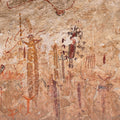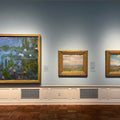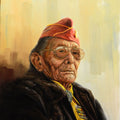'We Are Still Here' Pomo Artists at Sonoma Valley Museum of Art
By Medicine Man Gallery on

Meyo Marrufo with one of her dress designs at exhibition opening for We Are Still Here Pomo Artists and Our Cultural Landscape at the Sonoma Valley Museum of Art
Most of my writing centers on what I already know. I highlight artists I like who I want to see receive more attention and look for timely reasons to share histories familiar to me I want to broaden understanding of. Occasionally, as with this story, I enter with zero understanding. I enter with curiosity and the privilege of being able to ask my questions to people expert in the matters I’m wondering about.
I’m fortunate to write a great deal about Native American art, culture and history. I’ve come to learn those three are essentially one in the same. I’ve written extensively here and elsewhere about the Plains tribes, the Eastern Woodlands tribes, the tribes removed from the southeast to Indian Territory, the Pueblo tribes, even the Indigenous people of the Pacific Northwest. Seldom have I written about the Native people of California.
“We Are Still Here: Pomo Artists and Our Cultural Landscape,” on view now through April 30, 2023, at the Sonoma Valley Museum of Art, finally gave me the chance to ask one of my biggest lingering questions about Native America: why are the tribes in California so thoroughly overlooked when compared to tribes in other parts of what is now called the United States?
“Because of the amount of small tribes in California,” exhibition curator Meyo Marrufo, Eastern Pomo and enrolled member of the Robinson Rancheria Band of Pomo Indians, told me. “Our makeup is not like the Plains or the southwest or even the eastern people. We are small rancherias. There are 107 tribes in California; in Pomo Country there's 26.”
I was expecting a long answer; I received the opposite, delivered with the brevity and clarity only someone who deeply understands an issue can deliver.
In an instant, it all made sense.
Settler colonialism has never been interested in nuance when it comes to understanding Indigenous people, that goes for familial structure, governance, religion, land ownership and every other aspect of life. Finding the distinctions between the dozens of smaller tribes in California too bothersome to reckon with, the state and nation just moved on.
Exhibition text reads: “Traditionally, Pomo peoples did not think of themselves as a single entity, but identified themselves as the people belonging to a particular village. Anthropologists coined the term ‘Pomo’ and used it to refer to a large group of California Indians who shared seven similar languages, reasoning that they had all spoken an older parent language at some point in the distant past and so were all related in the present.”

Kathleen Smith, Mortar Rock, acrylic on canvas, 2010. Courtesy of the artist
Another reason lies in federal policy and can be understood through the life of Kathleen Smith (Bodega Miwok, Southern Pomo and enrolled member of Federated Indians of Graton Rancheria) who just turned 84 and has work on view in “We Are Still Here.”
“She helped start the California Indian Art movement in the time when you mostly saw Plains and Southwest artists,” Marrufo explains. “She came out as this California Indian artist with such different work than what was seen or known as to be contemporary Native American art.”
Smith graduated from the San Francisco Art Institute in 1977. Even by that time, the school had a rich history of welcoming Native American artists from around the country, many who would go on to prominent careers. Earl Biss (Apsáalooke), T.C. Cannon (Kiowa/Caddo) and Doug Hyde (Nez Perce, Assiniboine, Chippewa) all studied there.
But again, even here, the Native Californian artists were overshadowed by the more numerous Indian artists from elsewhere, mirroring a trend which went far beyond the art world.
“When you talk about an art movement that's happening and you talk about areas like San Francisco, L.A., Oakland, you're talking about these major cities, and they were relocation areas for all the other tribes in the United States. L.A. and Oakland were major relocation areas during the ‘50s,” Marrufo said.
American Indian Urban Relocation was an effort launched in the 1950s by the U.S. government to further disconnect Native People from their land and heritage. The Indian Relocation Act of 1956 incentivized Natives to leave their reservations for greater “opportunity” in cities like Denver, Chicago, Minneapolis and Cleveland.
“So you get this influx of all of these other people,” Marrufo continues. “Well, the California Indian people that are there are living in these small towns and living in these rural areas and in these small reservations, their art isn’t seen because they're not a bigger people.”
This reality did not go unnoticed or unrecognized by the Pomo, who over the years began working more closely together to increase their representation.
“The 26 Pomo tribes are now talking to each other, not that they didn't before, but now they're formally talking to each other,” Marrufo said. “As artists, we go, ‘hey, I'm Pomo too; look at my work.’ And there are now venues that want to see the people of the area instead of the people that came to the area.”
Like the Sonoma Valley Museum of Art.
“We Are Still Here” highlights contemporary artwork of Native Pomo artists, including Marrufo. The artists come from different Pomo regions and their art honors the cultural landscape and lives of the people in their communities. The exhibition also reflects the resilience of the Pomo Tribe – ergo the title – and the strong connections to their land as a place for ceremonies, family events, gatherings and religious observances.
Which is all well and good. Fifteen minutes into one of the most enlightening conversations I’ve ever had, however, Marrufo says, “let's talk about this show for a minute.”
I kind of thought we already had been, but please go on. As always, Marrufo had a point.
“I was approached to do this show – this is during the 200-year commemoration of (Mission San Francisco Solano located in Sonoma Town Square) – and when I was approached to do this show, I said, ‘oh,’” she remembers, laughing. “Yes, I will do this show, however, I am purposely not going to focus on this mission because what people expect to see is these angry Indians saying this mission did us wrong, but what they forget, and what we want (visitors) to take from this (exhibition), is that although everything has happened in the world, these people are thriving, and this is Pomo.”
This is Pomo.
“This is our cultural landscape, and not in a way that says, ‘this is our land, this is not your land.’ We understand colonization, people may privately own this land, but this is still our land,” Marrufo said. “We still care for it and love it, no matter who it belongs to, because it's still ours.”
This is Pomo.
“When Kathleen looks from where she is from – she has a piece (in the show) called Our Homeland, and it's of the Sonoma foothills – when people look at that, they might think, ‘oh, that's the so and so winery,’ yes, privately, that is, but historically, and traditionally, that is our homelands and we have a right to say, ‘hey, we don't want you doing these kinds of things on our homelands because it affects the whole of what is our homelands,’” Marrufo explains.
This is Pomo.
“I had both Natives and non-Natives that were like, ‘why wouldn’t you talk about (the missions)?’” Marrufo said. “Well, because it gets highlighted enough; it gets highlighted to the point where people think that's all we are. We are not just that, that's what I want people to see. We are not only a compilation of our historical trauma, we're more than that.”
They are Pomo.
And now you know. And so do I.

Meyo Marrufo, Oriole and Rosehips, giclee print, 2022. Courtesy of the artist




